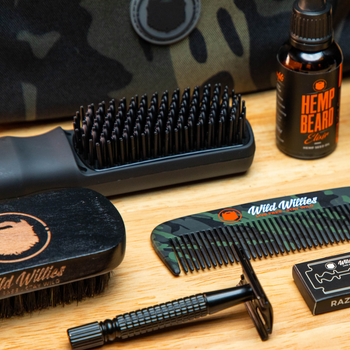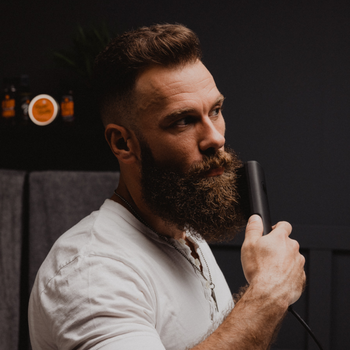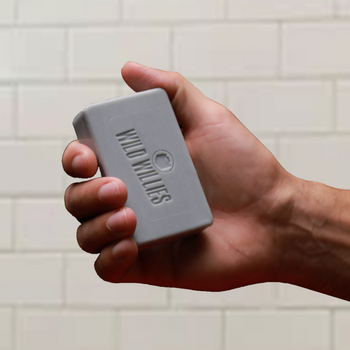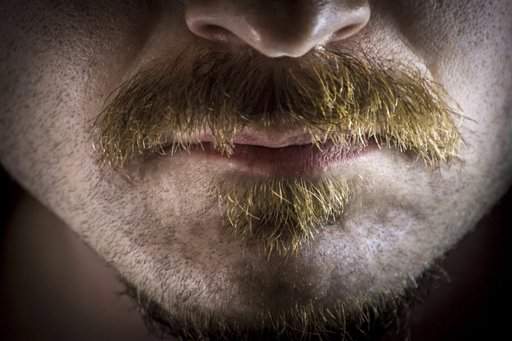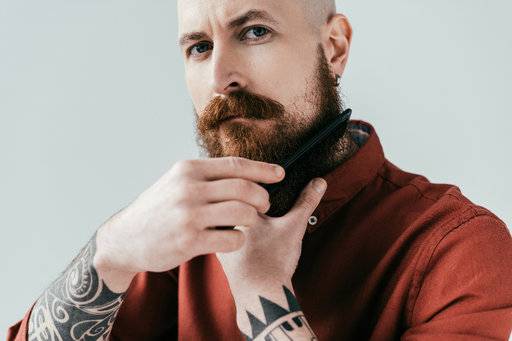Forget everything you've ever heard about beards not being for everyone. Every man deserves a bushy, beautiful beard. If you started the journey before but beard itch made you reach for the razor, we've got your back. At Wild Willies, we know behind every awesome beard was an awkward growth stage. Itchy scruff is sometimes unavoidable, but we can help you keep it to a minimum.
Table of Contents

Are You Ready To Grow?
Growing a beard is a daunting process if you're normally in the clean-shaven cohort. It comes with more hurdles for many employees because you may fear that facial hair can impact your professional appearance. Is a beard appropriate for your workplace? In most cases, the answer is yes. However, it depends on how much time you spend grooming and whether you create a gentlemanly style or let your face hair grow wild and untamed.
Benefits of a Beard
Looking at other men sporting beards, why wouldn't you want to join them on their facial hair journey? If you've had any hesitation about growing your beard, you may be surprised to learn that there are more than aesthetic benefits behind the decision. Mental and physical advantages come along with a full face of hair.
Aesthetics
Before we can dig into the health benefits of a good beard game, let's honor the aesthetic benefits. A beard performs both tasks for men who do not want to look so young and older men who want to look more youthful. Older men tend to look younger when sporting a face mane, while young men look older and more mature. It projects maturity and some may be more likely to assume you to be a seasoned professional when you have a beard.
If you want to change up your personal fashion, sporting a beard may open the door for better clothing options. When you decide to grow out your hair, not only do you need to pay attention to grooming to keep yourself from looking like a feral wild man, but you need to dress in a more polished way to enhance the look of the beard. You may find that you put more effort into the clothes you choose, possibly even enhancing your professional life.
Health
Beards are also a sign of health! With full facial hair, you may appear stronger and as though you have more vitality. Those who interact with bearded men may also tell you that facial hair projects trustworthiness. Often, men in the medical field tend to grow beards to convey their trustworthiness.
Reputation
Naturally, people look to those with facial hair as leaders. After all, beards are associated with masculinity. You become a part of a wider community of men with facial hair when you grow yours out. Many men start to feel more confident when they have good-looking growth.
Protection
Did you know your beard can serve as a natural filter for allergens? The hair catches pollen and dust and prevents them from entering the respiratory system. If you have asthma or hayfever, a beard is a natural way to avoid symptoms in the spring and summer. Keep in mind that the size and length of the beard determine the amount of protection.
Likewise, a beard protects against the hot summer sun. While you don't want to forget to treat the rest of your face with care during the warmer months, facial hair offers a natural barrier between your skin and the sun.
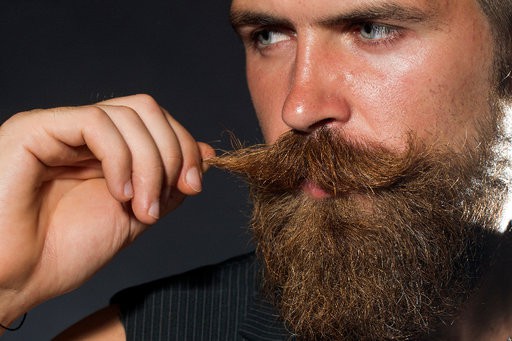
Ways To Grow a Lucious Beard
On the surface, growing a beard sounds easy — just stop shaving. If you want enviable whiskers, however, you have to put in a little more effort. Start with a game plan. Know your aesthetic and figure out the steps to take to reach your ultimate goal. When you're used to a clean-shaven face, the process is going to feel out of the ordinary even without beard itch. Your scruff may seem awkward and far from your ultimate goal in the early stage.
Be patient with your hair growth. Remind yourself what you're going to look like when it's finished. Remembering your goal can keep you from reaching for the razor because you're impatient. If you have the chance, begin your growth over a holiday or long weekend. Quit shaving on a Tuesday so you'll be scruffy by Friday when you don't have to worry about what your colleagues and friends may say about your beard length.
If you want to avoid looking like a scraggly lion, groom often. Establish your neck and cheek lines as early as possible and begin to trim your beard after the first or second week. Grooming and maintaining the hair stops you from looking rough and unkempt even in the earlier stages. Hair doesn't always grow in a uniform pattern. Trimming outliers keeps you away from the wispy look. Most beard styles require more length near the front and bottom, but you cannot guarantee your growth to adhere to this pattern without maintenance.

What Is Beard Itch?
Ask any man and he'll tell you that growing a beard isn't always a comfortable experience. It's common to develop an itchy beard, particularly when you start the process.
Signs of Beard Itch
At times, the itch may be hardly noticeable and ignorable. At others, you may feel like every inch of your face itches and you cannot focus on anything else. If you catch yourself tossing and turning at night, wanting to dig your hands into your facial hair, then you have a serious case of beard itch. Luckily, this discomfort can be remedied.
Causes of the Itch
The hair on your chin isn't the same as the hair on your hair. Experts refer to it as androgenic hair, which means the growth is driven by testosterone. This hair tends to grow differently and thicker.
Beard Growth
The most common cause of beard itch is the act of growing out previously cut hairs. When you shave, you create a sharp edge on the end of the hair. The sharp edge scratches the follicle or tiny tube that holds the hair as the hair grows. If you shaved for a long time before growing out your beard, you are more likely to suffer from itchy skin.
Ingrown Hairs
Red, bumpy follicles point to ingrown hairs. After shaving, some hairs grow back into the follicle. As a follicle becomes inflamed, it causes discomfort. If you have a tight, curly beard, you are more likely to have to watch out for ingrown hairs.
Dry Skin
In cold or dry months, the skin under your beard may become dry and flaky. Additionally, medications and face products can affect your skin's oils. When the skin under the beard dries up, it leaves you wishing you could scratch it. Likewise, if you suffer from eczema or psoriasis, it can impact your comfort.
Seborrheic Dermatitus
Seborrheic dermatitis can affect your scalp and face, particularly if you have oily skin. You may notice yellow scales and red skin. On the scalp, seborrheic dermatitis is dandruff. You may have the dreaded beardruff if you find flakes in your beard.
Pseudofolliculitis Barbae
Pseudofolliculitis barbae refers to the inflammation of the follicle as the hair cuts into the skin or curves back around during growth. You may develop razor bumps or blisters. While an infection does not cause the bumps, blisters can lead to an infection.
Folliculitis
Folliculitis is the inflammation of the hair follicle. It happens most often because of a fungal, viral or bacterial infection. Folliculitis causes tenderness. Your skin may feel tender to the touch and even painful. Sometimes, the inflammation leads to blistering.
Tinea Barbae
Tinea barbae is a fungal infection. Signs of infection include red, inflamed skin around the mouth, chin and cheeks. If you have beard itch due to tinea barbae, you most likely caught it while in contact with horses or livestock.

What Beard Itch Remedies Should You Stock Up On?
Part of planning for a fuller style is to prepare for any discomfort that may come up. If you want to obtain a certain aesthetic, you're going to need most of these products anyway. By being proactive, you're less likely to encounter an itch that you can't remedy.
Face and Beard Wash
Hygiene is the most important way to prevent bacteria and dirt from building up. When in the shower, be careful not to use excessive heat because it dries out your skin. Use beard and face wash every day to avoid excess oils and buildup.
Beards trap oil and dirt differently than the hair on your head. Regular hair shampoo may strip your beard and face of moisture, but our beard washes don't strip the sebum oil out of your beard. Instead, we include Vitamin E, eucalyptus, lemongrass and peppermint to restore moisture and hydrate the skin.
Beard Conditioner
How you treat your beard after a good washing can make or break how you feel later. Skipping the conditioning stage can result in an itchy, dry beard for the rest of the day. A lack of conditioner can lead to dandruff, inflammation and hair loss. Sometimes, dandruff can clog the pores and cause the hair to fall out.
Traditional beard conditioners, oils and serums restore moisture. Forego products with harsh chemicals that damage hair and skin. Look for ingredients like argan oil, jojoba oil, essential oils and aloe.
Beard Medication
Sometimes you need to fight beard itch with medication. If you have constant itching or a skin infection beneath your beard, you may require different ointments, lotions or creams. If you have chronic dry skin, start with a good moisturizer. Creams that utilize lactic acid can help prevent flakes in your beard.
Seborrheic Dermatitus
The best medication for beardruff is low-dose topical steroids. Applying hydrocortisone helps when you have an acute inflammation. For more severe outbreaks, you may require an antifungal product or clobetasol.
Pseudofolliculitis Barbae
When treating pseudofolliculitis barbae, grow your hair for at least three to four weeks with no shaving. By letting your beard grow, you're allowing the lesions to heal. Never shave your beard every day if you suffer from the condition. In addition, you can use glycolic acid to treat the discomfort.
Folliculitis
Ointments and creams used to treat bacterial and fungal infections can help treat folliculitis. Mupirocin and a corticosteroid cream may be effective treatments. Likewise, applying benzoyl peroxide can help if you are prone to folliculitis.
Tinea Barbae
For fungal infections, you will most likely require topical antifungal therapy. However, if you have a more serious infection, you may need oral antifungal treatment. Working with a dermatologist for any skin infection should yield better results.
Beard Combs
Scratching your face is not only unsightly but a hazard for your skin. While it's tempting to scratch during the awkward growth phase, keep your fingers out of your beard and grab a comb instead. A high-quality comb can stay in your back pocket to not only tame your mane but to satisfy the itchiness. Our Trendsetter Grooming Kit comes with shampoo, conditioner and a comb for everyday use.
Shaving Techniques
There is a reason we recommend growing your beard out over the weekend and avoiding shaving it in the early stages. While this means you have to reach an awkward length for a short time, it can also prevent the development of ingrown hairs. Allow the hair to grow past the follicles to prevent damage and skin irritation.
To minimize discomfort, wet your skin before you shave. If you have naturally dry skin, use a gel or shaving cream for sensitive skin. Always follow the direction the hair grows and rinse with every swipe of your razor. Never keep your blades for more than seven shaves. When you do shave or trim, try natural aftershave and lotions. Tea tree oil and aloe vera are gentle moisturizers found in various products.
Grow More, Scratch Less With Wild Willies
If you're ready to change up your appearance and see your bearded self in the mirror every day, there is never a better time to start growing. Before you embrace beard culture, make a game plan for how you want to grow your facial hair and how you plan to care for it. The more focus you put into the products you put on your face, the more likely you are to feel comfort rather than beard itch that keeps you up at night.
